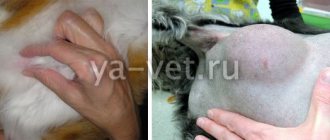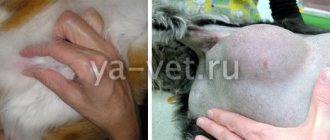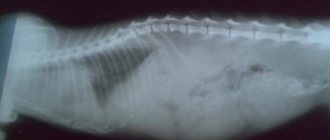If swelling of a cat's paw is observed, this may be a symptom of a traumatic injury, circulatory problems due to pinching of blood vessels during play or veterinary procedures. Swelling of the front or hind limbs also occurs due to arthritis, osteomyelitis, osteochondrodystrophy, and tumors. The owner needs to know how to provide first aid to the pet and urgently take it to the veterinary clinic, where the doctor will prescribe treatment.
According to veterinarian statistics, pets under 5 years of age are most susceptible to injury due to excessive curiosity, as well as older cats who have reduced resistance to microbes, which leads to inflammatory processes in their paws.
Causes of swelling
Traumatic injuries
If a cat's paw is swollen, this is a symptom of a severe bruise, dislocation or closed fracture without displacement. When a bruise occurs, soft tissue is compressed and a hematoma is formed. During a dislocation, the articular head is displaced from the bursa, and during a fracture, the integrity of the bone is disrupted. The main reason is a fall from a height while playing or hunting for birds and insects, a car injury, a hit with the front legs on a heavy object when the cat moves quickly. If the pad of your foot is bleeding, there may be a splinter in your paw. Symptoms:
Often, a dislocation of one of the joints of a limb can manifest itself in this way.
- Strong pain. At the same time, the pet tries not to step on the paw.
- Swelling.
- Hematoma. Noticeable if you move the fur apart.
- Joint deformation (dislocation).
- Aggression. The cat does not allow you to touch the sore spot.
Veterinary manipulations
It happens that after surgery an animal is forced to undergo a long course of IV drips. If a cat's paw with a catheter is swollen, this is due to a temporary disruption of blood and lymph flow. After removing the tube, the swelling goes away. Often, swelling appears after a drip or injections, when the needle misses a vein and fluid accumulates under the skin. The paw pads swell due to squeezing of the vessels by fixatives - a splint, an elastic bandage, a splint. The kitten's paw swells, hurts and turns blue due to the fact that during play the finger was wrapped in an elastic band, which disrupted blood circulation.
Diseases of the musculoskeletal system
Joint inflammation (arthritis)
Inflammation in the joints is considered to be a fairly common ailment among fluffies.
If your cat has a swollen paw, this could be a sign of arthritis. From the surrounding blood vessels, effusion enters the joint cavity, which increases the production of synovial fluid and causes the joint to swell. The cause of the disease is untreated injuries to the front or hind legs, infectious diseases, frequent hypothermia, and age-related changes. Often, arthritis contributes to the development of arthrosis, when articular cartilage is destroyed and bone growths appear. Symptoms:
- severe pain, in which the cat limps or does not step on a limb;
- limited mobility;
- puffiness and swelling;
- local or general hyperthermia.
Osteochondrodystrophy
It is most often diagnosed in fold-eared cats and is a hereditary disease. It occurs due to incorrectly selected breeding animals that have a “fold-eared” gene, which softens not only the ear cartilage, but also the entire cartilaginous tissue, which is why swelling and deformation are observed on the legs. Manifestation:
A lop-eared pet with this disease is often limited in its movements.
- lameness;
- stiffness of movements;
- unsteadiness of gait;
- limited movement;
- shortening or curvature of paws;
- dwarfism
Osteomyelitis
It is characterized by a purulent process of all bone structures - body, bone marrow. The cause of development is stab wounds or bites inflicted on the pet during a fight with relatives. When an infection occurs, inflammation develops, which is accompanied by the following symptoms:
- severe pain, swelling;
- lameness;
- temperature increase;
- general deterioration of condition;
- refusal of food;
- the formation of deep ulcers with purulent and bloody discharge.
Neoplasms
Such a symptom in the limb area can occur against the background of cancer in an animal.
Swelling of a cat's paw can cause cancer. Predisposing factors include decreased immunity, hormonal imbalance, poor diet, constant stress and inhalation of cigarette smoke, if the owner smokes indoors, and the cat living in an environmentally unfavorable area. The front or back leg swells when skin cancer develops. Symptoms:
- bumps between fingers;
- ulcers in the ears, genitals, throughout the skin, on the face (nose, lips);
- fast fatiguability;
- loss of appetite.
Calm, only calm: we observe and inspect
The first thing to do if your furry dog has a swollen paw is to observe his behavior. Don't panic and remember: in the process of monitoring your pet, you should get all the useful information possible. It is important for you to understand:
- whether the animal is in pain;
- is he afraid to lean on his swollen paw?
- Is your pet limping?
- has the cat become less mobile?
- whether he experiences atypical stiffness in movements;
- Is the animal bothered by itching?
At the next stage, you need to carefully and carefully examine the sore paw, and then the entire pet. This will reveal additional symptoms:
- the presence of open wounds and suppuration in the area of edema;
- changes in skin color in swollen areas (redness, paleness, or blueness);
- local temperature change;
- the appearance of peeling, dandruff, unpleasant odor;
- increased salivation and watery eyes of the animal;
- soreness in areas adjacent to the swollen body.
Peeling skin on a swollen area of a cat's paw is an additional symptom that should not be ignored.
It is important to remember that when conducting such an examination there are no trifles: if you contact a specialist, any deviation from the norm you notice (even the most insignificant) can help in making the correct diagnosis.
Your further actions will directly depend on the results obtained from observing and examining the cat.
What to do in an emergency?
In case of injury or after surgery, the owner should know how to provide first aid to the pet:
- If a cat's hind legs are swollen after anesthesia, and the sore spot is hot when touched, it may be thrombophlebitis. You should lubricate the limb with Troxevasin liniment and take the pet to the veterinary clinic.
- If you have tightened your paw with a clamp, you need to loosen it a little so that blood circulation is restored and the swelling goes away.
- In case of a bruise, you should apply a cold compress, alternating for 15 minutes, which will help relieve pain and prevent the development of swelling.
The sore limb of the fluffy needs to be secured with a bandage.
For fractures and dislocations, the algorithm for assistance is as follows:
- Provide rest to the limbs and limit the cat’s mobility.
- Apply a cold compress.
- Secure the paw with planks, making a soft spacer between the skin and the clamp.
- Apply a bandage, not too tight.
First aid if your paw is swollen
When a cat's paw is swollen and he is limping, you need to know exactly what to do in order to quickly provide first aid to the animal. The pet is examined for wounds and bruises. If you have them, you can treat them at home yourself. In severe cases, it is better to contact a veterinary clinic. Standard care for wounds and minor blisters includes:
- rinsing with chlorhexidine and hydrogen peroxide;
- treating the skin around the injury with iodine or alcohol;
- applying a bandage soaked in levomekol or ichthyol ointment.
The cat lost his voice: reasons and what to do
Since limbs can swell for many reasons, do not put off visiting the veterinarian. It is not so difficult to find a suitable specialist; it is important that the examination is carried out on time and treatment is prescribed as soon as possible.
Cats also get plaster casts.
Note! After prescribing treatment, the owner will need to provide the pet with the necessary care, bandage it, give medications and follow a schedule.
How is the treatment carried out?
All medications are prescribed by a doctor. It is forbidden to treat your pet yourself; this leads to serious consequences. In inflammatory processes, when the front or hind legs are affected, antibiotics are used, which are prescribed individually based on the etiology. A malignant tumor on a cat's paw can be eliminated by surgery. If necessary, a course of chemotherapy or radiation therapy is carried out. If the leg is swollen due to a dislocation or fracture, the veterinarian replaces the articular heads and immobilizes the limb. In difficult cases, surgery is performed.
The mechanism of edema
Speaking about the mechanism of edema, first of all, it is worth noting that there are two reasons for the pathological accumulation of fluid in tissues:
- Increased pressure in small vessels.
- Changes in the amount of proteins in plasma (the liquid component of blood) and increased permeability of vascular walls due to inflammatory processes, toxin poisoning, and disorders of nervous activity.
Moreover, the fluid that accumulates in the tissues can also be different. So, the following can lead to swelling:
- Blood;
- Lymph;
- Pus;
And the swelling itself can be:
- Limited (localized), covering small areas, and general (generalized), covering large areas;
- Symmetrical and asymmetrical (in this case, for example, the paw may swell).
Diagnostic methods
Regardless of the cause of the edema, it is always necessary to carry out diagnostics, which are done in an inpatient setting. This should be done by a doctor, after an examination he will be able to make an accurate diagnosis. Diagnostics helps to find out what caused the swelling, especially if it is impossible to identify visible damage and recognize the causes of the symptoms. Primary diagnosis includes a standard external examination of the limb and the animal as a whole.
The cat is limping on its front leg without visible damage
Important! It is necessary to carry out a diagnosis in any case; you should not treat your pet at home on your own without a veterinarian. This is fraught with negative consequences and deterioration of the animal’s condition.
X-ray of paws
After an external examination, blood and other body fluids are tested and, if necessary, a cardiogram is performed to evaluate the functioning of the heart. To assess damage to a limb, your doctor will perform an MRI or X-ray to check for fractures, dislocations, and bruises. If the diagnosis is confirmed, the swollen limb is treated and treatment is prescribed.
Cat wounds
Most often, cats have bitten, lacerated “battle wounds” received in fights with other cats or dogs. The most obvious sign of such wounds is damage to the skin, which requires appropriate treatment. First of all, the wound must be washed with a disinfectant. A regular solution of furatsilin is suitable for this. If you don’t have a ready-made solution, you can prepare it yourself by dissolving two tablets in a glass of warm boiled water. The surface of the wound is treated with this solution. If possible, remove fur from the area around the injury to prevent hair from sticking to the wound.
When the owner is unable to immediately deliver the injured cat to a veterinarian, she should be given an antibiotic. If the owner does not have a special veterinary antibiotic at hand, it can be replaced with a human drug, for example, Augmentin (amoxiclav). The antibiotic is given in a dosage of 12-15 mg per 1 kg of animal body weight twice a day. That is, an “average” cat that weighs 3 kg should receive about 50 mg of antibiotic at one time. And, of course, the animal needs to be shown to a veterinarian as soon as possible.
If the cat received a cut wound and started bleeding, then you need to do the following: take a clean, or better yet, sterile napkin, apply it to the surface of the wound and bandage it with moderate force. The pressing effect will reduce bleeding. If a large artery is damaged, it will most likely have to be sutured. Bleeding from small vessels can stop on its own, but treatment of such a wound still requires the supervision of a specialist.
Eye injuries are also common in cats and, unfortunately, in this case, the owner can do practically nothing himself. The damaged eye should be carefully washed with furatsilin solution and immediately consult a doctor.
Cats also have so-called abscesses. They usually develop as complications if the wound has not been washed with an antiseptic. Pathogenic microorganisms enter it and begin to develop, causing a cavity with pus to appear under the skin - an abscess itself. Externally, an abscess manifests itself as swelling, a “bump” on the skin and painful sensations when touched, since the cavity compresses the nerve endings. Sometimes the abscess opens spontaneously and pus is released from the wound. However, even in this case, it is better not to hope for the animal’s independent recovery. An abscess requires mandatory intervention by a veterinarian, because antibiotics alone cannot suppress a purulent focus. It is necessary to open and wash this cavity, install drainage in it and maintain it until the pathogenic process stops.
Tumor of the lower jaw in a cat: causes and treatment
Oral pathologies in cats are a rare occurrence. Most often, old or weakened animals encounter neoplasms, inflammatory processes and bacterial lesions of the mouth and jaw.
A tumor of the lower jaw in cats is difficult to treat at home and is difficult to diagnose, so you should consult a veterinarian.
The results of the X-ray examination will allow us to draw conclusions about the nature of the tumor.
Diseases of the teeth and oral cavity
If a cat's lower jaw is swollen, the likely cause is oral disease. In older cats we are talking about dental diseases. With age, teeth begin to loosen, lose hardness, and begin to crumble.
Any microcracks in the enamel lead to the development of a pathological process, which results in complete decay of the tooth.
In cats, the roots of the teeth are located deep in the gum tissue, so tooth decay can lead to the formation of a seal on the lower jaw. Associated symptoms:
- refusal to eat;
- jaw turned to one side;
- lethargy and weakness;
- no pain when pressed.
Typically, animals with dental problems refuse to eat.
At the same time, the cat experiences severe hunger and can in every possible way attract attention to its own bowl, but as soon as it is filled, the pet will turn away and leave. This is because chewing food causes pain.
The structure of the tumor will tell you about the possible causes. If a hard neoplasm is noticeable upon palpation, but the cat breaks out and does not allow itself to be touched, a cyst of the lower jaw is a possible cause. This neoplasm can be caused by dental diseases and is an overgrowth of bone tissue in the lower jaw.
If a soft and heterogeneous structure is noted upon palpation, the possible cause is an abscess, the development of which is due to the presence of pathogenic microorganisms in the oral cavity. This happens when pathogenic agents penetrate deeply into the root of the tooth. The abscess must be opened surgically, but there are cases when it breaks out on its own.
Possibly what could cause a cat's eyes to fester?
Diseases of the oral cavity and teeth in cats are indicated by foul breath, red gums and impaired jaw movement during eating.
This pathology can only be treated surgically - it is necessary to remove rotten teeth, open an abscess or cyst. If the abscess has opened on its own, antiseptic treatment should be carried out several times a day to avoid secondary infection of the wound cavity.
During surgical removal, the doctor must prescribe antibiotics to prevent infection of healthy oral tissues.
Malignant and benign neoplasms
Malignant tumors in the mouth of animals are rare. However, if the jaw of a cat over 13 years of age is swollen, cancer can only be ruled out after a comprehensive examination of the animal.
There are usually no specific symptoms for jaw cancer. The animal may become lethargic and refuse to eat, but these same signs accompany an abscess and dental problems.
To make an accurate diagnosis, it is necessary to take an X-ray of the jaw and take a blood test to identify the inflammatory process. If the presence of a tumor is confirmed, an operation is performed to remove it, followed by tissue examination.
For malignant neoplasms, animals are prescribed a course of chemotherapy.
The danger of malignant neoplasms is that they are rarely accompanied by significant symptoms. A jaw tumor at the beginning of development manifests itself in the same way as dental problems, but can cost the cat his life.
With osteosarcoma and squamous cell carcinoma of the jaw, pain is pronounced. The animal cannot chew, drink water, and does not allow the affected area to be touched. In some cases, syringe feeding may be necessary
It is important not to try to treat your pet on your own, but to visit a doctor in a timely manner
Other reasons
Swelling of the lower jaw and lips in cats can be caused by household injuries. An older cat may accidentally scratch his lip when chewing hard food. As a result, it will swell and upon external examination it will appear that it is a swollen jaw.
Burns to which animals that like to chew wires or taste food on the stove are also susceptible. Despite the apparent harmlessness, household injuries should be treated.
Any wounds and injuries are treated with an antiseptic; for burns, you should use a special product to speed up healing.











